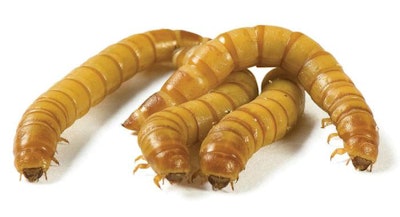
The edible insect sector was a buzz in late 2015 as the European Food Safety Authority (EFSA) published its first risk assessment on the use of insects for human and animal consumption, which states the risks involved with producing insect protein are similar to the risks involved with all animal protein. This was followed a month later by an update to the European Union’s novel food regulation to now include insects for human consumption.
“With the legal frameworks now becoming settled, the further development to use insects for food and animal feed is now unfolding quickly,” says Food and Agriculture Organization (FAO) senior forestry officer, Paul Vantomme.
Currently it is an offense to feed farmed insects to food-producing animals. Legislation inspired by mad cow disease prohibits feeding animal protein to food-producing animals in Europe. Because insects are considered animals, they are not permitted in the diets of commercially raised insectivores such as poultry.
What we know about insects for animal feed
According to research, farmed insects may offer a more efficient and sustainable source of protein in poultry and aquaculture diets than do soybean meal and fishmeal. Insects may offer a lower cost protein alternative with a good amino acid profile.
“Farmed insect products for animal feed reduce the share of human-grade grains (soy, corn) and fishmeal in compound feeds, so liberating more of these grains for direct human consumption,” wrote Vantomme in an email. He explains that insects can be fed on food waste, manure and other agricultural waste streams that are not fit for animal feed. Thus, greatly reducing the dependency of Europe and China on South American fishmeal and soy.

Meal worms are used for human nutrition and in livestock feeds in some countries and can be raised on some food waste and food manufacturing byproducts. | iStockPhoto.com, andrewburgess
Because insects are cold-blooded they have naturally low feed-conversion ratios. This means that raising them for animal feed could be an efficient step to reducing the dependency on land for growing grains. Approximately 30 percent of the crops grown in the world are used for livestock feed. This number is expected to increase by 2050 to meet the growing global population.
How protein output affects what we feed insects
Raising insects as a source of protein for animal feed has been an attractive idea due to their ability to feed on organic side streams such as manure and food waste — approximately 1.3 billion tons of food goes to waste every year. But insects are, in essence, what they eat according to recent research by Mark Lundy, an agronomist from the University of California Division of Agriculture and Natural Resources, and Michael Parella, an entomologist from UC Davis: Crickets Are Not a Free Lunch: Protein Capture from Scalable Organic Side-Streams via High-Density Populations of Acheta domesticus.
The research studied the protein output of crickets that were fed different food substrates: crop residue, processed food waste and poultry feed. In the study, nearly all the crickets that were fed a diet solely of crop residue died while the crickets that were fed grain-based poultry feed had the highest amount of protein conversion.
While this research focused on crickets, other insects, like the black soldier fly, may have differing conversion rates when fed a diet of food waste. Nonetheless, the study states that it’s important to factor in the diet when calculating protein output from insects: “In order for insect cultivation to sustainably augment the global supply of protein, more work is needed to identify species and design processes that capture protein from scalable, low-value, organic side-streams, which are not currently consumed by conventional livestock.”
Studies are being done to measure what effect adding a percentage of food waste to a grain-based diet would have without lowering the nutrient output of the insect. Utilizing food waste would both lower the cost of insect production and lower the amount of food that is sent to the landfill.
Are insects the animal feed of the future?
There is going to be a devastating impact on the environment if insects are not re-entered into the food chain, warns Canadian insect farmer and co-founder of Entomo Farms, Jarrod Goldin.
“Nature had it right to begin with,” says Goldin, who raises a variety of insects including mealworms, waxworms, superworms and crickets for both consumers and backyard chicken farmers. “We’re doing studies on poultry and aquaculture that are fed insects, and the benefits are tremendous because insects are more nutrient dense,” he says. “Ironically, how could feeding an insectivore grain be better than feeding it a cricket?”
Goldin has seen an increase in interest in insect protein for animal feed. But whether the animal feed industry is allowed to use insect protein in feed for food-producing animals ultimately comes down to government regulation. “This [government regulation] will take a while, and we’ll need a ridiculous event to get the change made,” says Goldin.
Will insects feed the 9 billion?
The future of insect protein in animal feed ultimately relies on innovation and government regulation. Nonetheless, researchers and producers are confident that insects will play a significant role in feeding the growing population. The question is when?

















